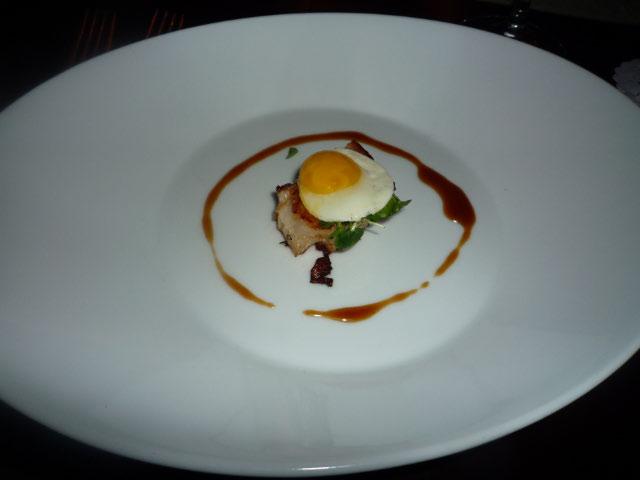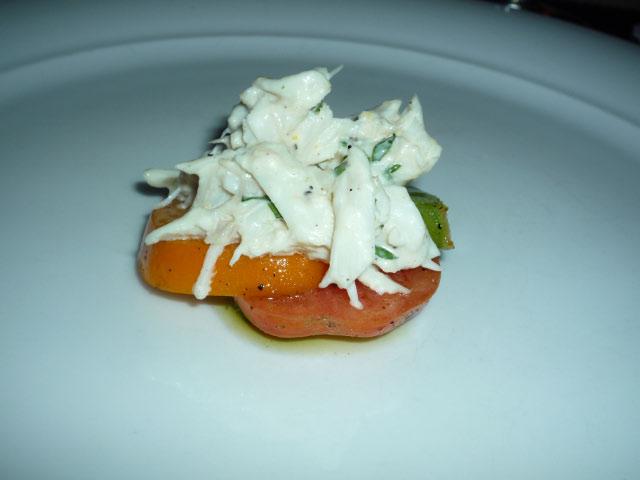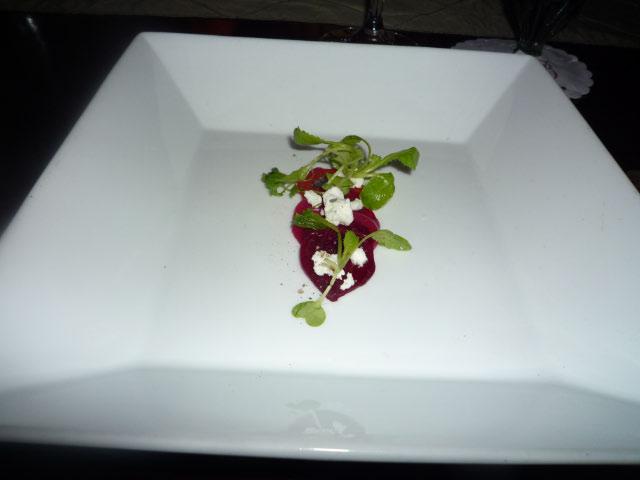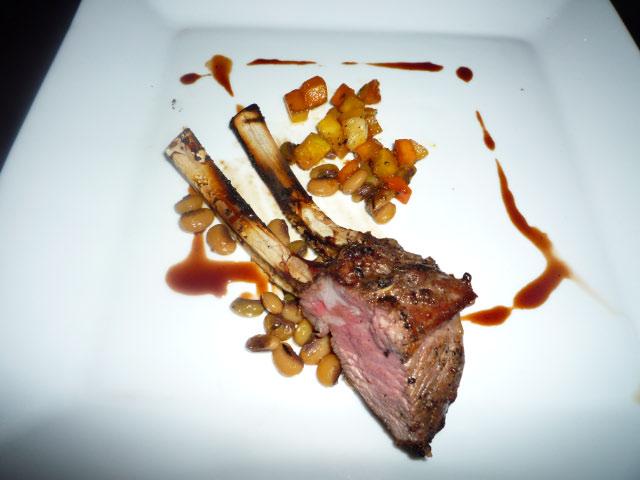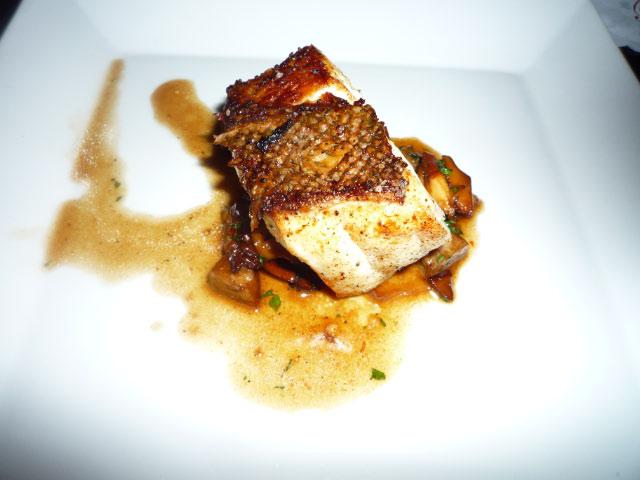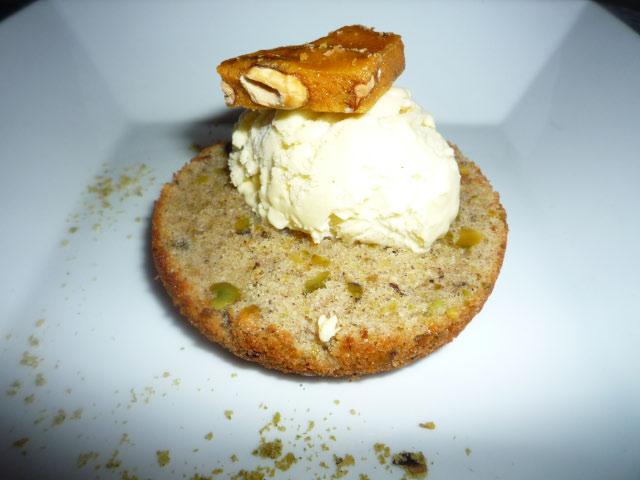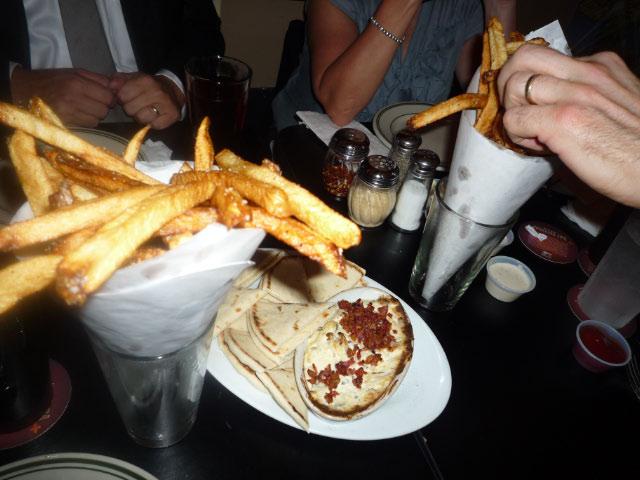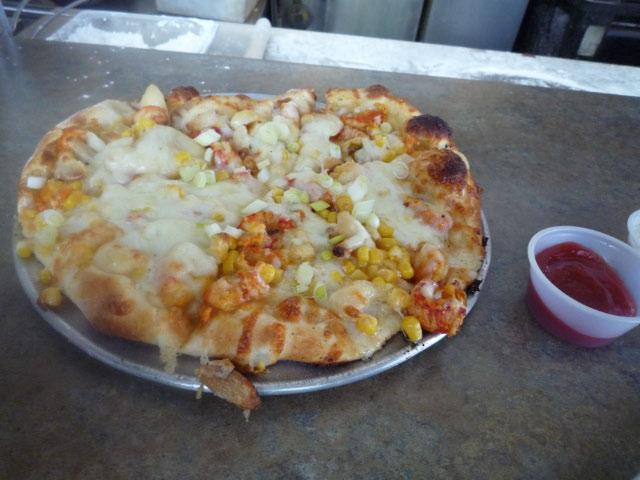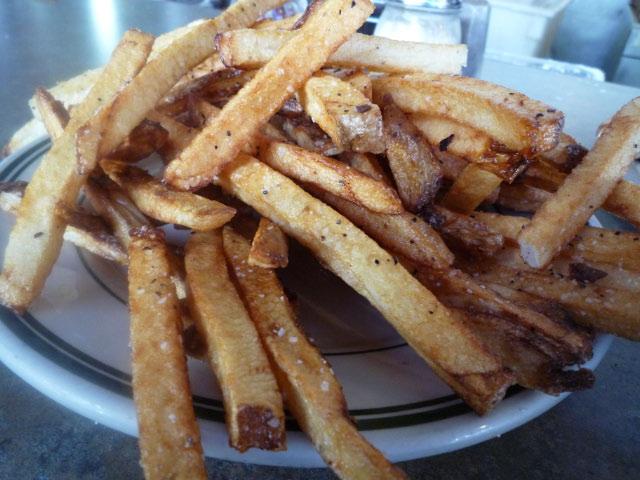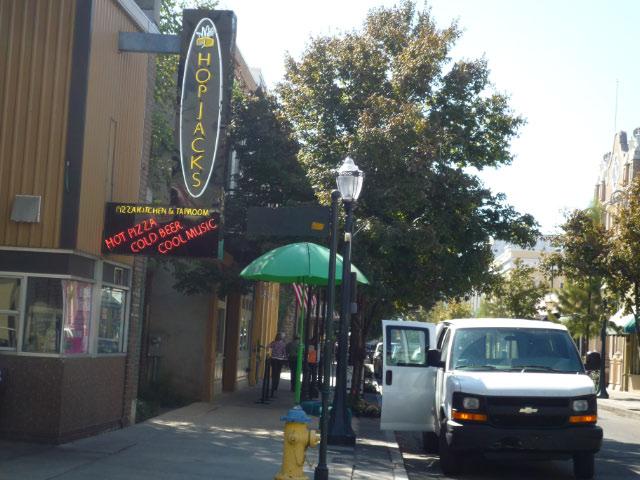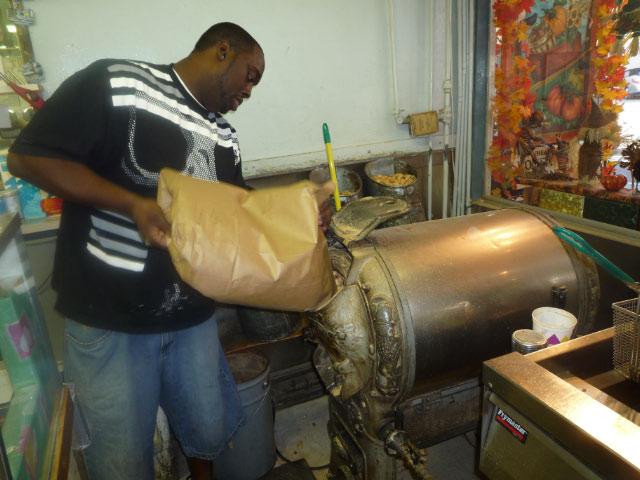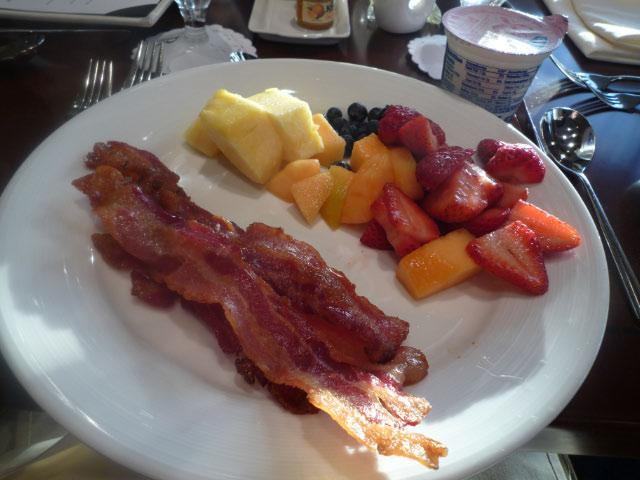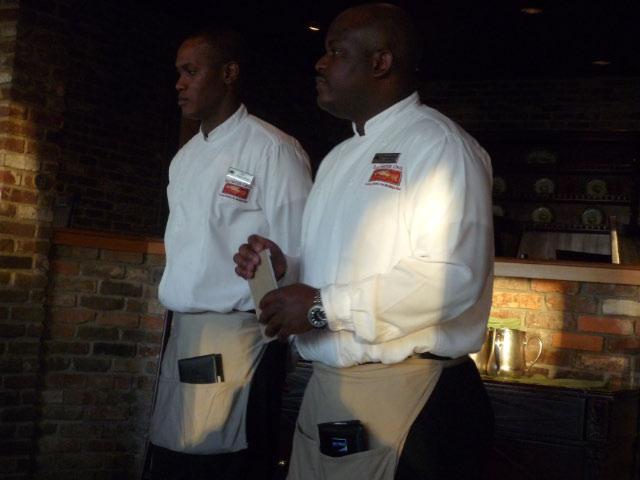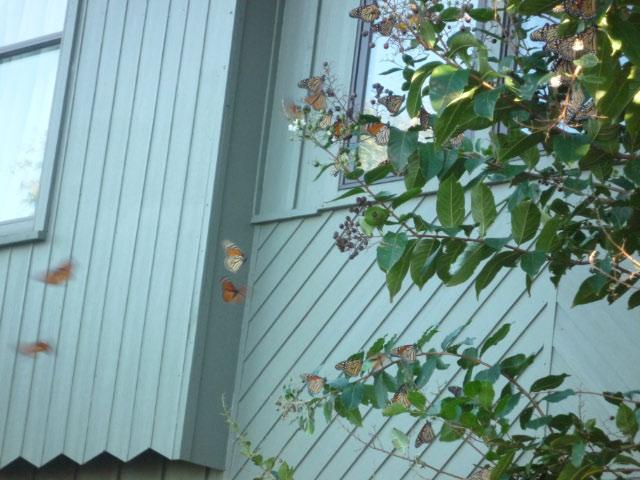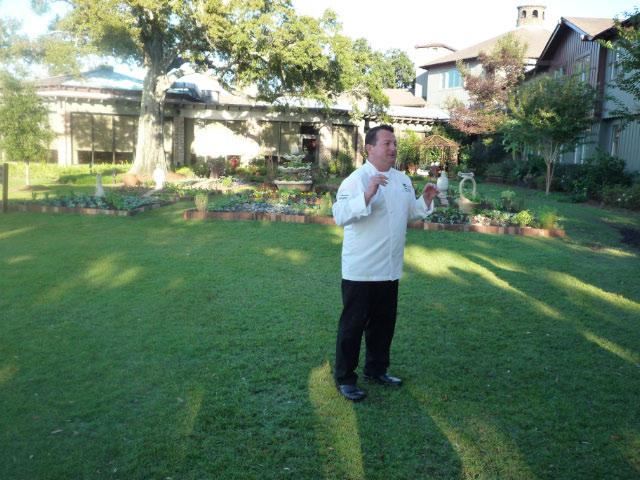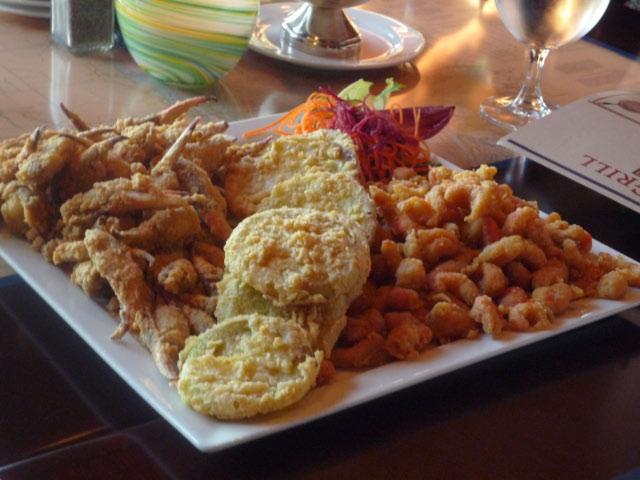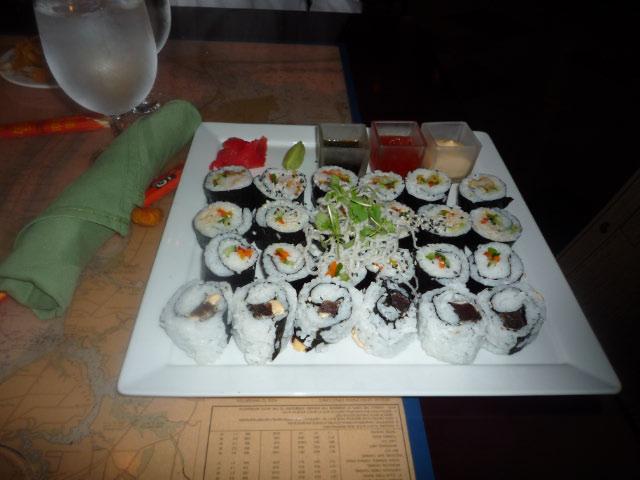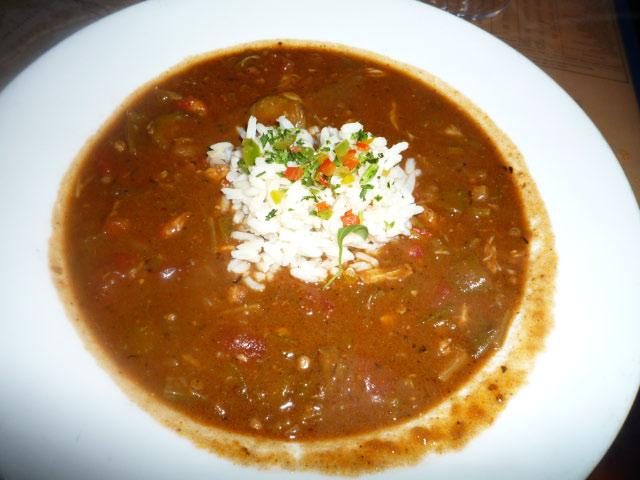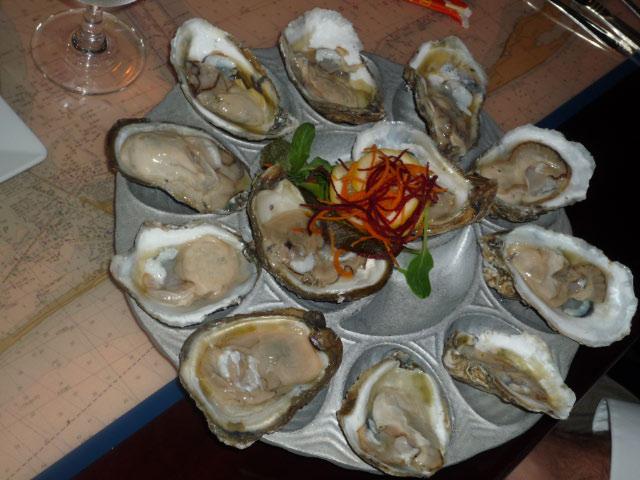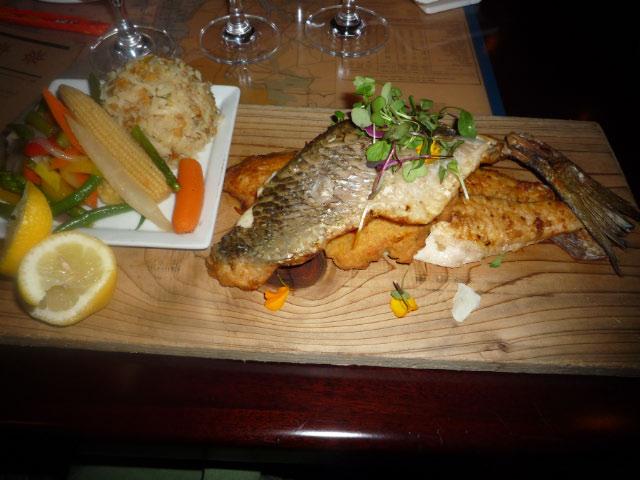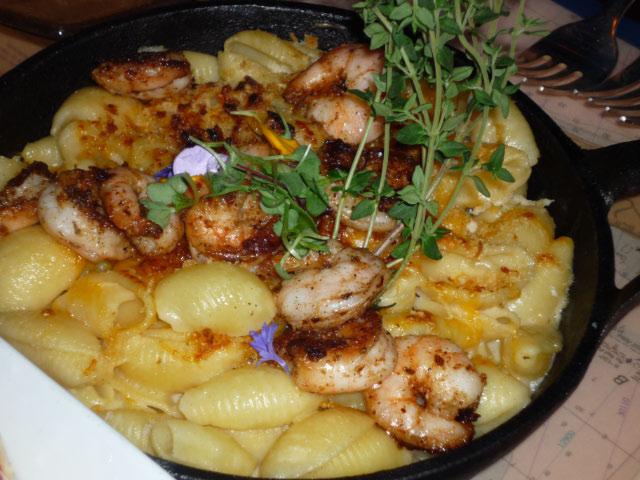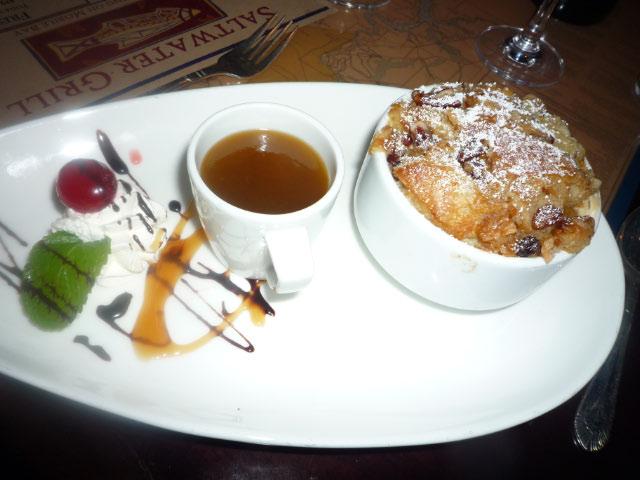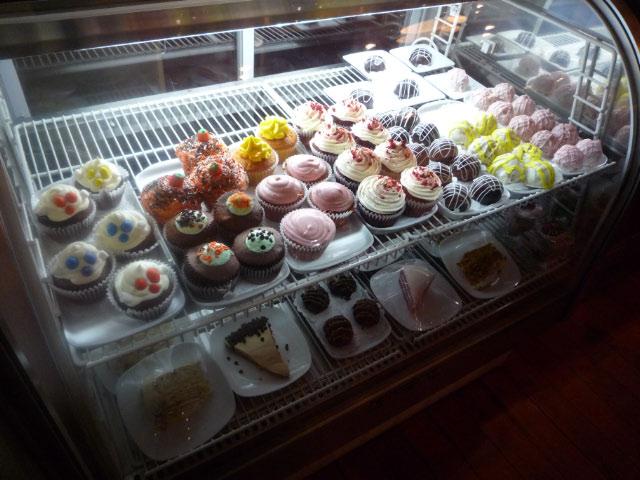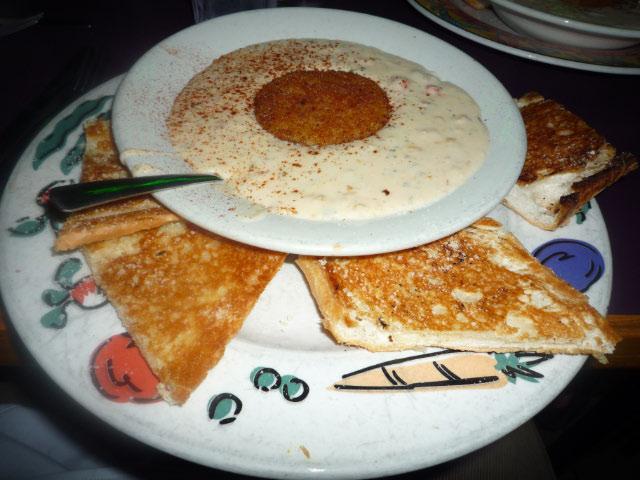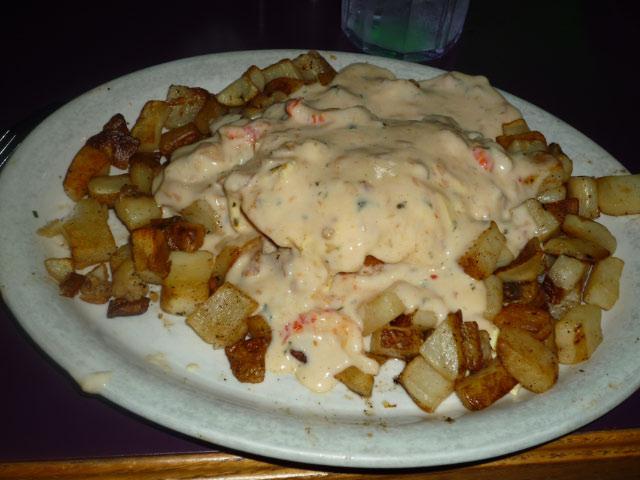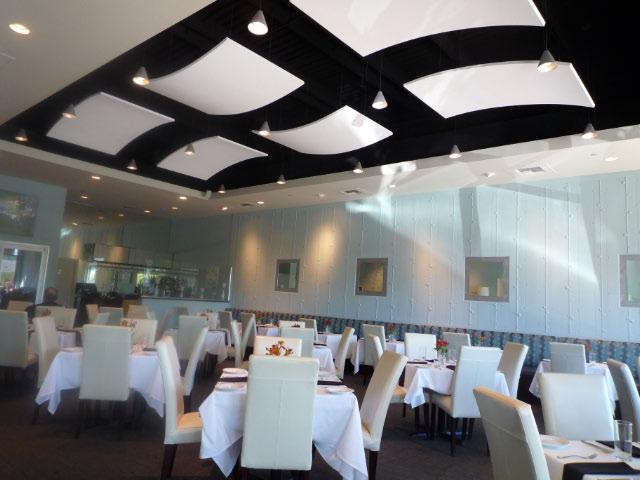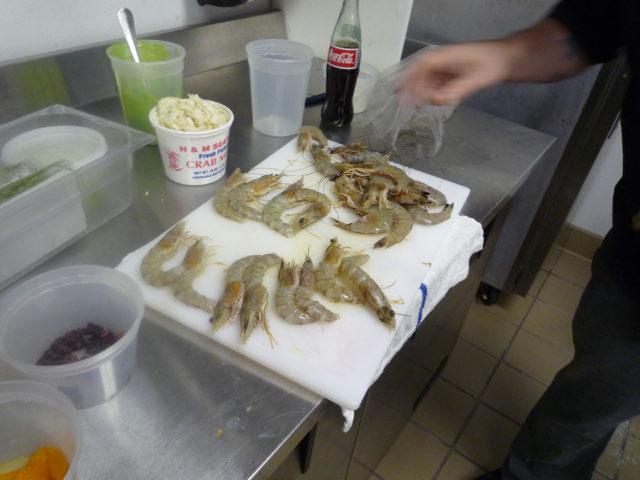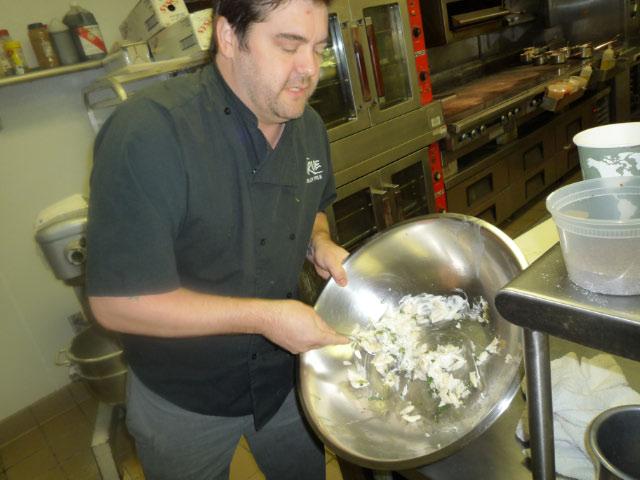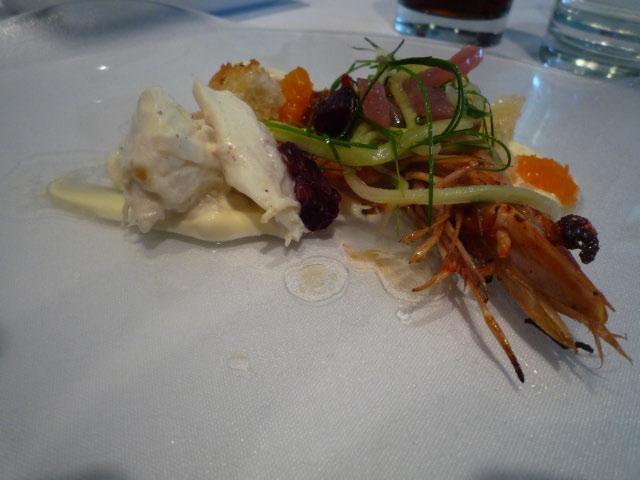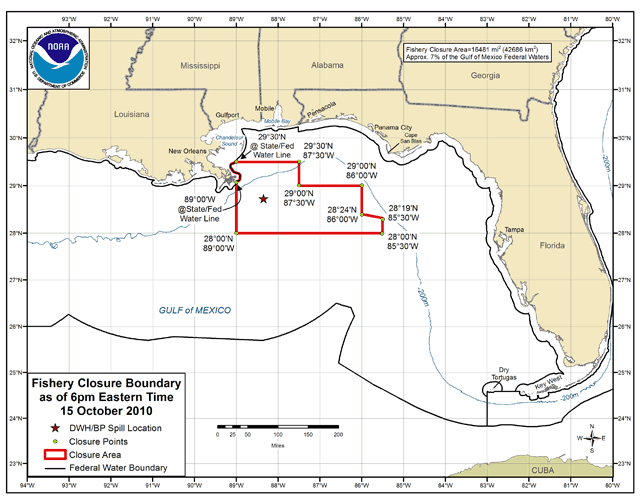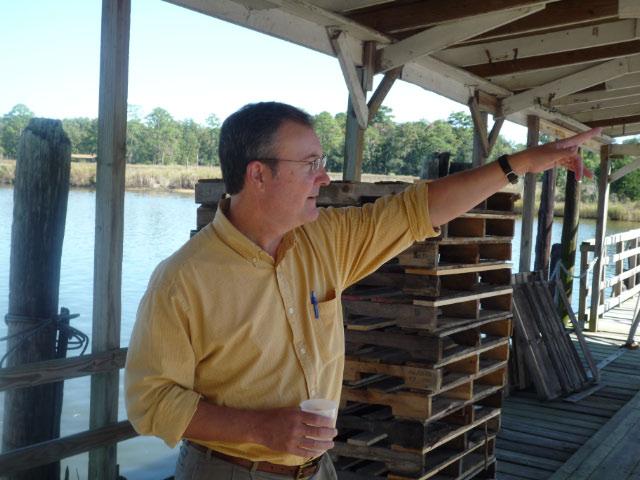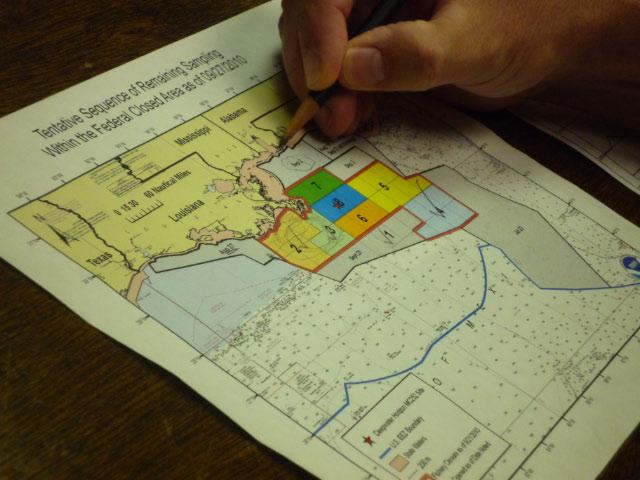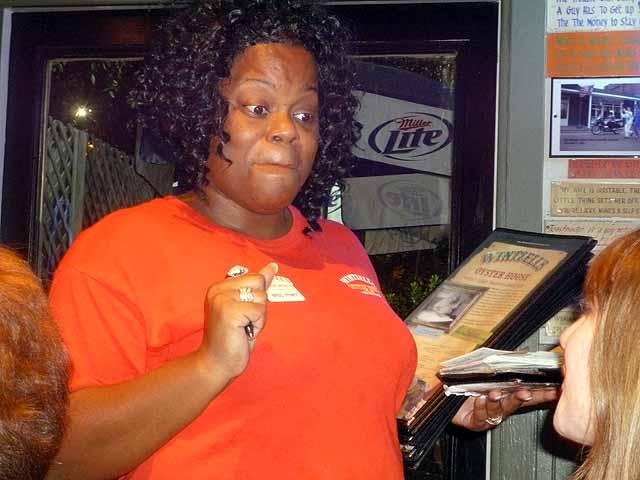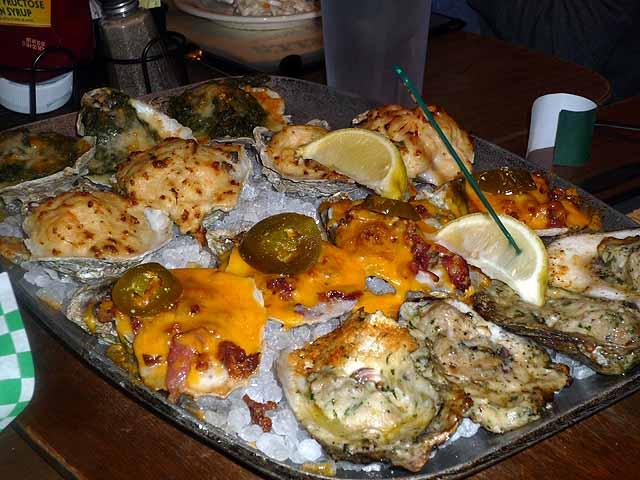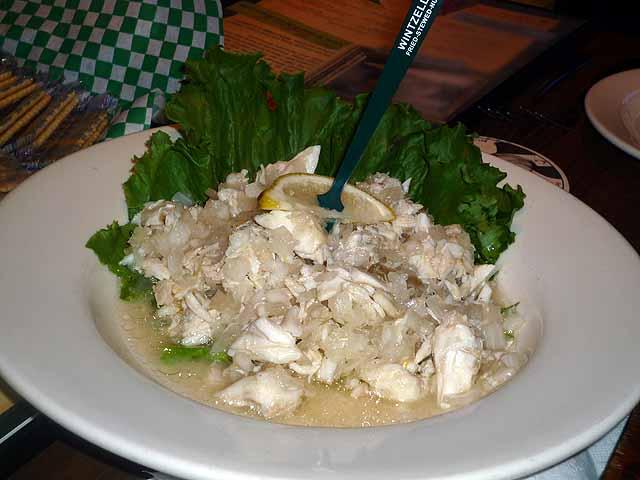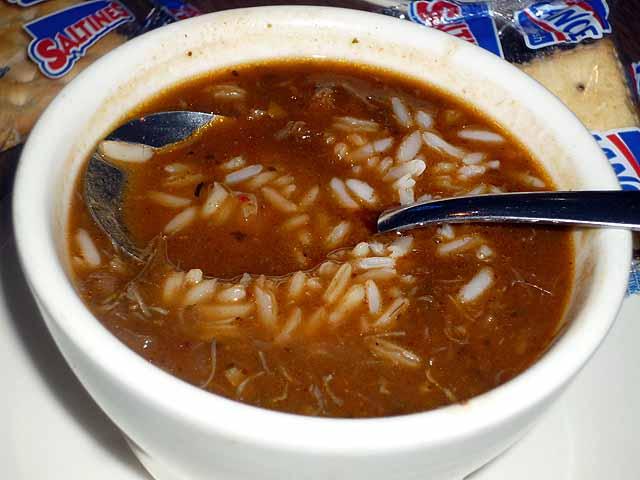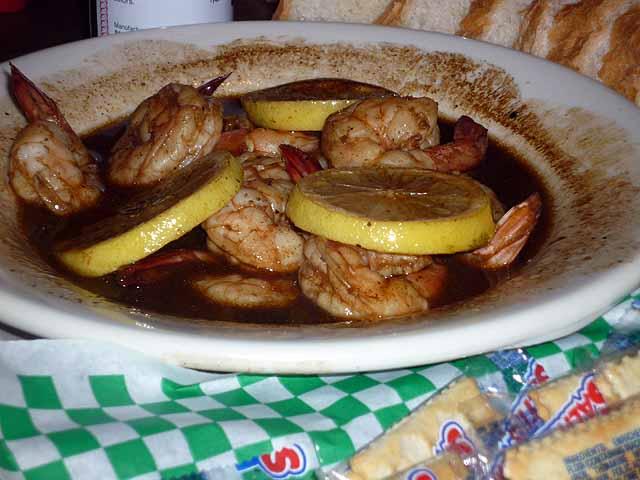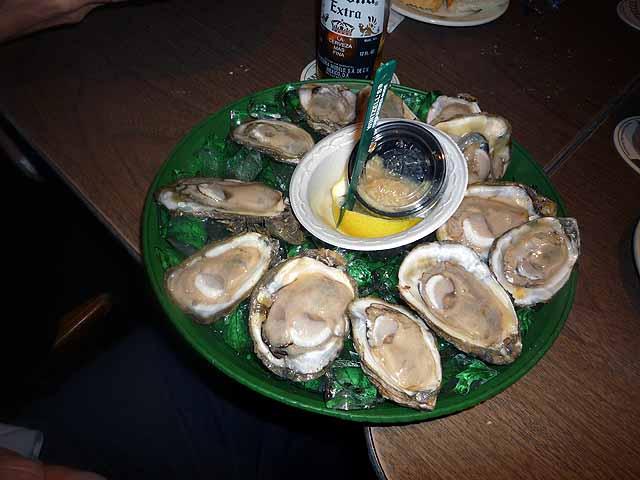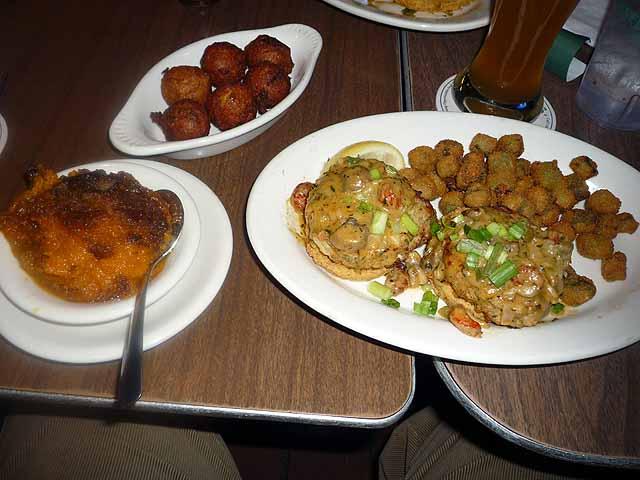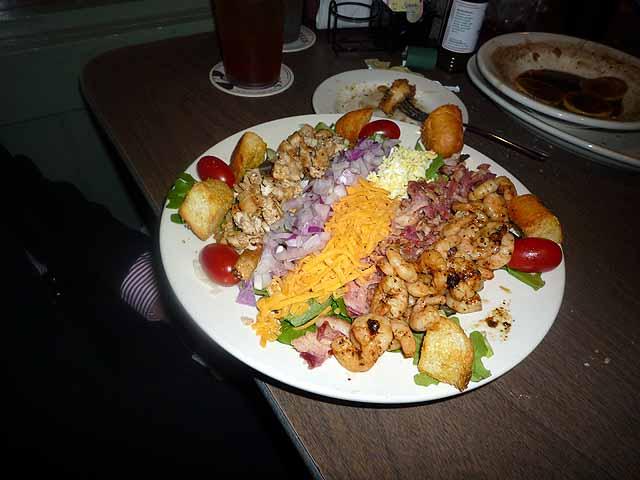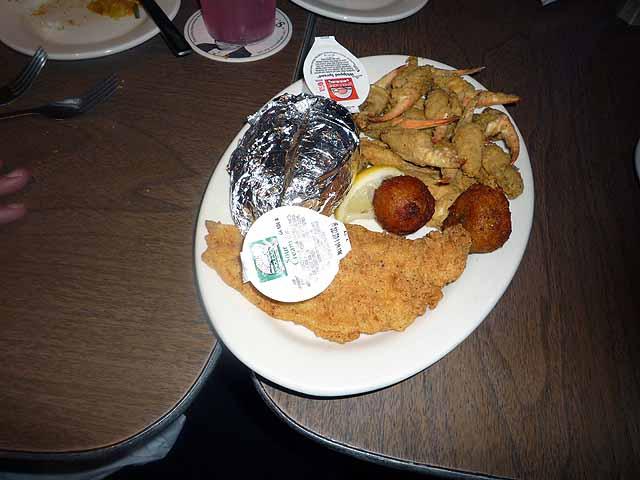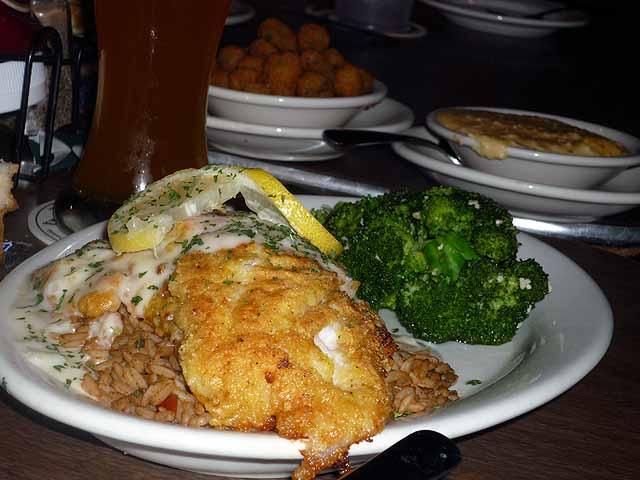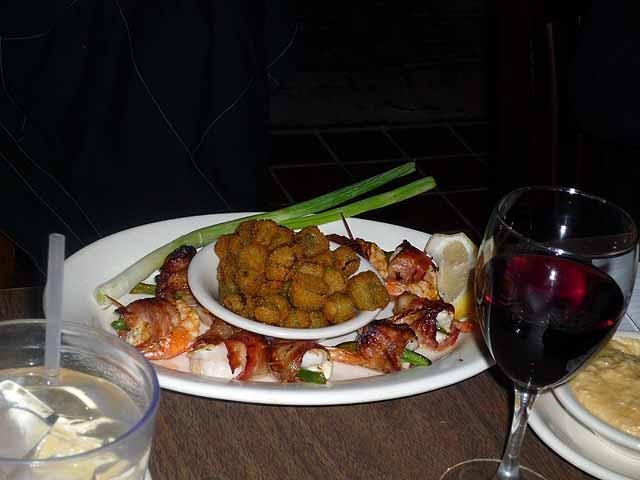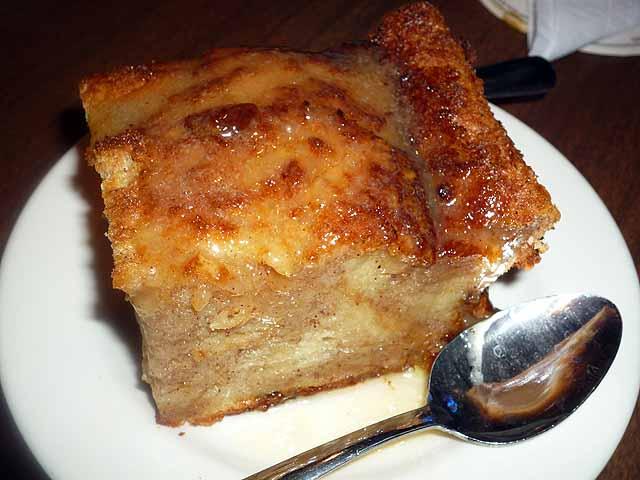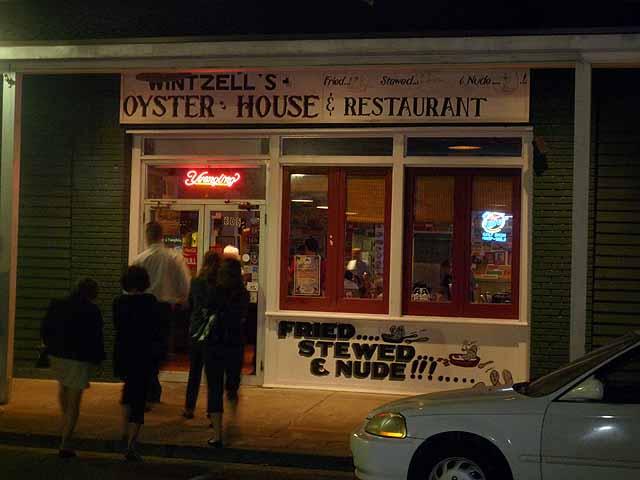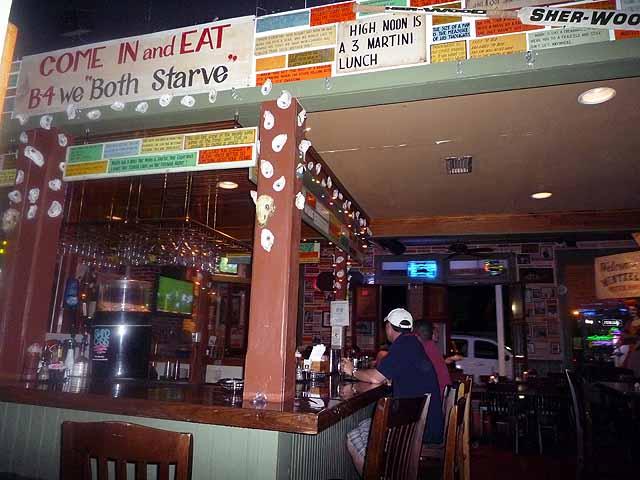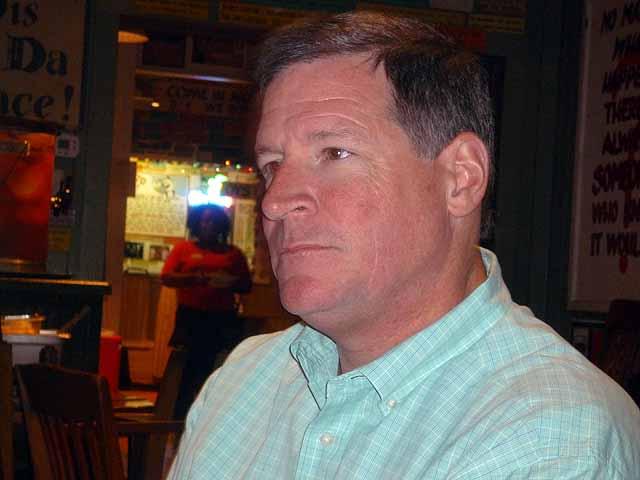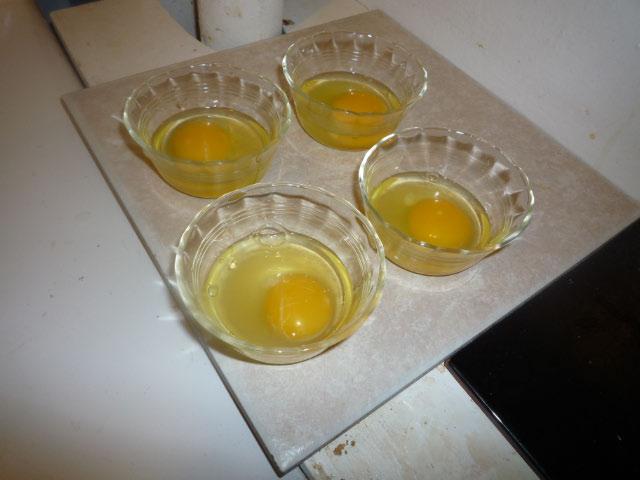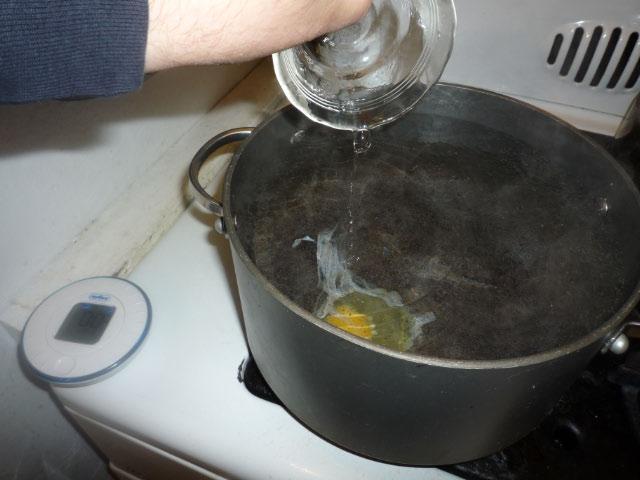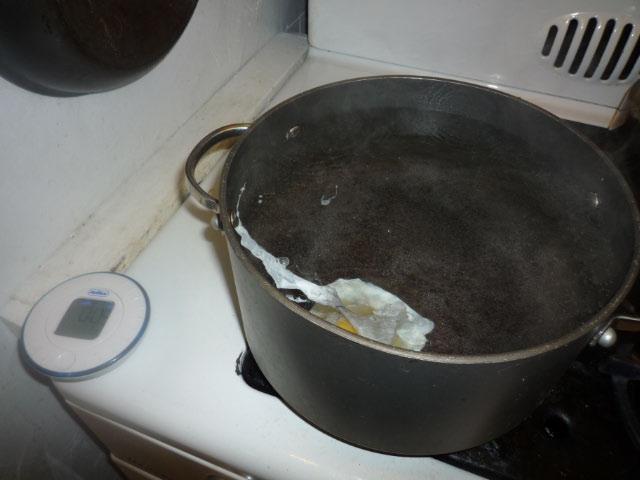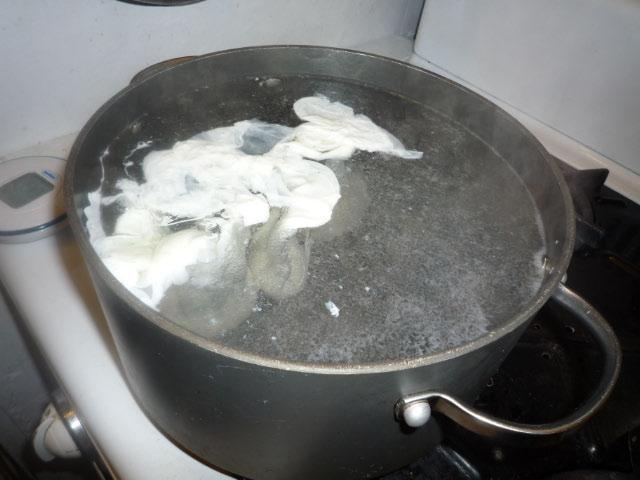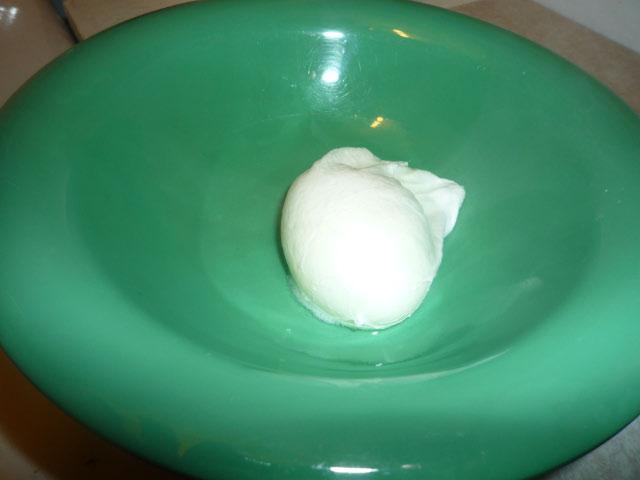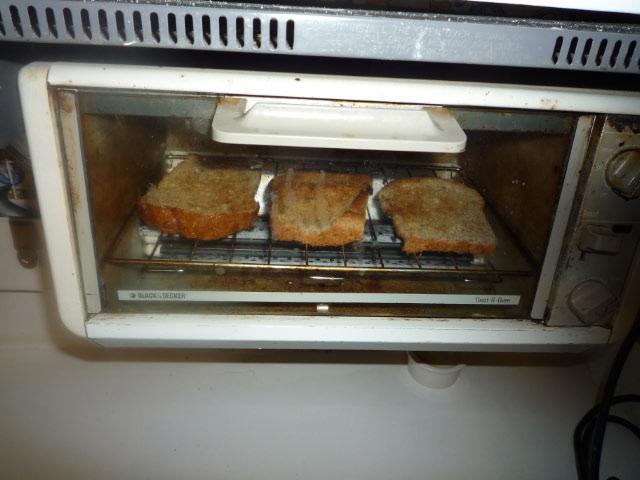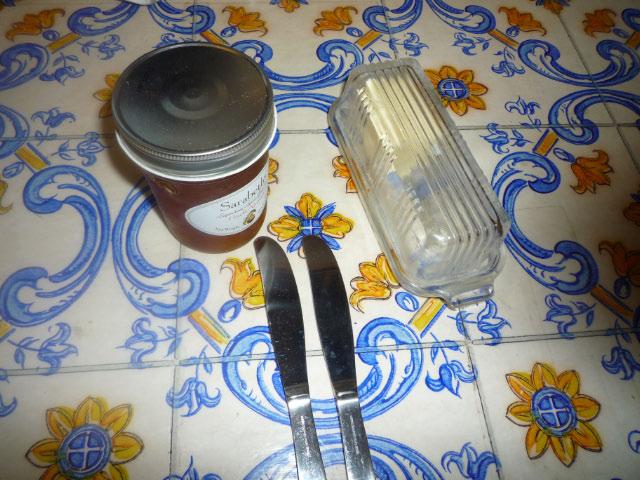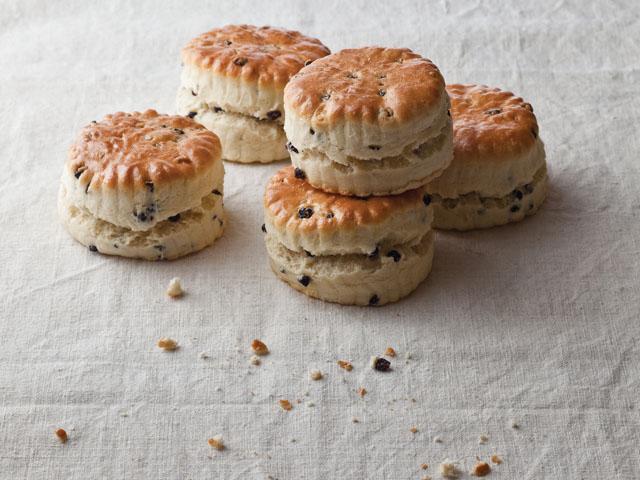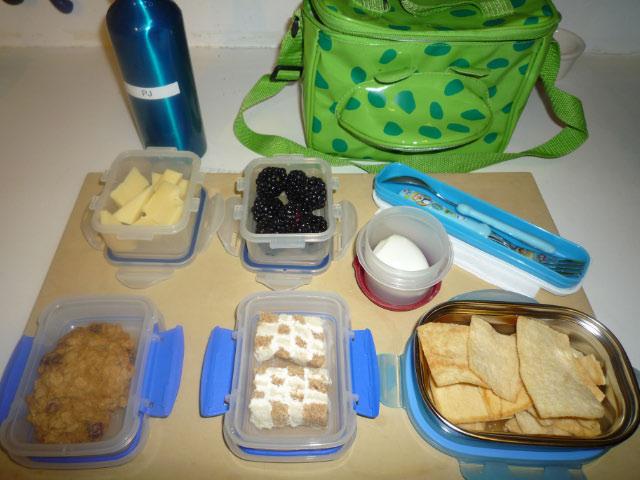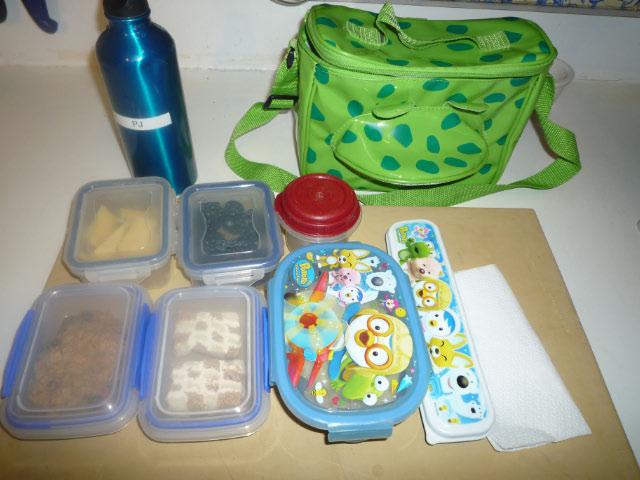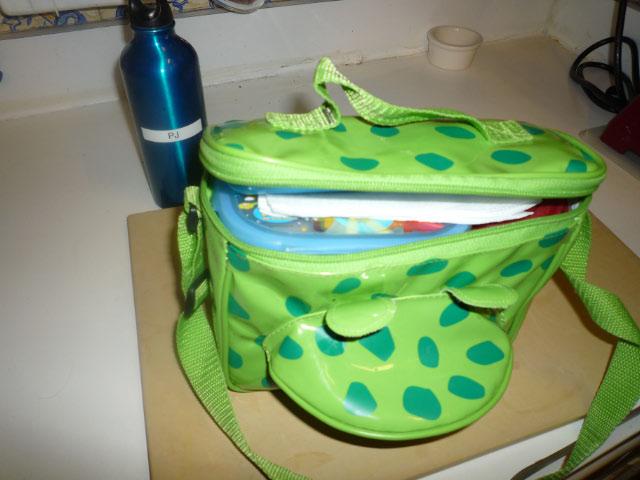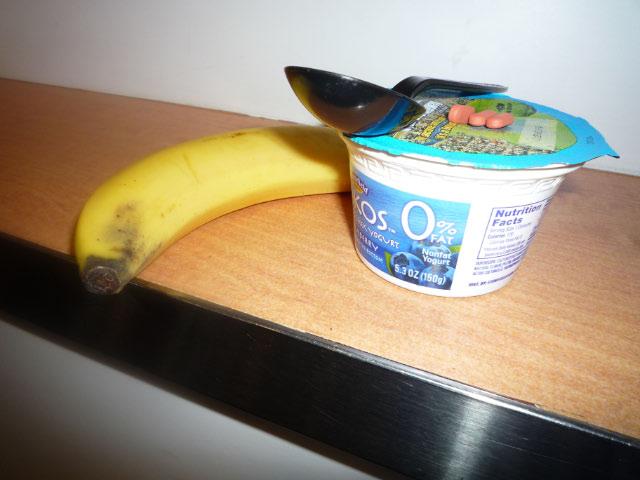-
Posts
28,458 -
Joined
-
Last visited
Content Type
Profiles
Forums
Store
Help Articles
Everything posted by Fat Guy
-
I think it was something akin to a thick bechamel, applied lightly -- but that's just my operating theory. Tonight's dinner was at the Trellis Room, which is the fine-dining restaurant in the Battle House Hotel where we're staying. The chef's name is Marty Pollock, from Buffalo, New York. I thought his food was the most successful of the weekend, mostly because it wasn't covered in white sauce but also because he works within the Southern metaphor while incorporating a lighter, more contemporary approach. He put together a seven-course tasting menu that he felt highlighted a number of the best available regional ingredients. We started out with braised pork belly topped with a quail egg and micro watercress. The printed menu we received after the meal also mentioned white truffle oil. I didn't taste that, and I'm glad I didn't. Otherwise, the dish was a success. Photo: Ellen R. Shapiro Next, crab salad with heirloom tomatoes and almond-basil pesto. The pesto was particularly good. Photo: Ellen R. Shapiro Beets with goat cheese, herb salad and lemon vinaigrette. I actually thought this was the best dish of the evening to the extent there were no flaws at all, and every ingredient really popped. Photo: Ellen R. Shapiro Royal Red shrimp "scampi" with fresh fettuccine. Royal Red shrimp? I thought above we discussed the impossibility of getting Royal Red shrimp right now. Tonight we heard a different story. So there do seem to be at least some Royal Red shrimp in the supply line. Photo: Ellen R. Shapiro Pan-roasted grouper with wild mushroom-andouills ragout. Here I thought the grouper was a little overcooked. Photo: Ellen R. Shapiro Lamb with pink-eyed peas, autumn squash and bing cherry demi-glace. The sauce was very concentrated and sweet, but nobody was forcing us to use it. Photo: Ellen R. Shapiro Dessert was pistachio cake with olive-oil ice cream and pistachio brittle. Everyone at the table loved this dessert, except me. Go figure. Photo: Ellen R. Shapiro After dinner we went to Bonkerz Comedy Club. The less said about that the better. Finally, I returned to Hopjack's with a group to take another look at those fries. Photo: Ellen R. Shapiro Still great flavor; still not crispy enough. There was some debate at the table as to why. I personally think the duck fat just doesn't get the fries crispy enough. Other theories ranged from "temperature too low" to "needs more time." Again, great flavor, but limp texture.
-
It's interesting, there are 10 journalists on this trip. At any given time, there might be three or more activity choices, so that a given writer can focus on relevant activities and not everybody will be doing the same research. Wouldn't you know, though, for this morning all 10 journalists chose the massage at the hotel spa. The last massage I had was on Grand Street in Chinatown in Manhattan where I paid $41 for a 60-minute session of Qi Gong, which basically involves a sadistic little woman beating you up with her elbows on a table in a dark closet. I can't even imagine the retail price of the hour-long massage I got today from Rebecca at The Spa at The Battle House. The spa is cleverly housed on the roof of the hotel's parking structure. The hotel's designers figured out that nobody likes to park on the top level of a parking deck, especially in the South where it's so damn hot, so instead they made the parking-deck roof into an oasis with spa, swimming pool and fitness center. When you enter the spa, you walk down a hall with water walls on each side of you. Ridiculously friendly people -- a lot of them -- greet you, call you Mr. or Ms. Whatever often, guide you to the locker room where you get a robe and slippers in your size and program a locker with your own electronic code, then take you to the "Men's Quiet Room." In the quiet room, I sat in my padded satin Hugh Hefner robe and had complementary cranberry juice and mixed nuts. There was also an array of fresh fruit, tea and granola to choose from, not to mention a hot tub and sauna that I didn't use. After I quieted down in that room for a bit, someone came and led me to Rebecca's massage room -- though to call it a room understates things. It was more of a facility. She conducted a quick but thorough medical interview (she is a nurse too) and then worked on my wretched body for an hour with particular attention to my rotator cuff tendinitis. Afterwards, I could have stayed at the spa all day. Many people seemed to be doing just that, swimming in the pool and hanging around in various states of undress. But I had to keep eating. This afternoon I kept my schedule open in order to visit three local food establishments on my own. I started out with my finest culinary experience of the trip so far: a late lunch at Hopjacks. The original Hopjacks is in Pensacola and the Mobile branch -- the only other branch -- is newer, but it looks like it has been around for ages. It's basically a divey bar with a crazy-large selection of beers and an unexpectedly ambitious pizza, sandwich and salad menu. Pizza topping choices include things like roasted duck, crawfish and filet mignon. I sat at the bar so I could watch the cook at work at the pizza ovens. He looked like he had just ridden in on his Harley and was just making a few pies before going off to rob a bank. My waitress, who looked like she came on the back of the cook's Hog, turned out to be a real pro -- a Union Square Cafe server dressed like a biker chick. We talked through the menu and I settled on a Cajun Crawfish pizza: spicy crayfish and white sauce topped with green onions, corn and roasted garlic. Photo: Ellen R. Shapiro In addition -- and this is what's going to make eGullet people want to get on a plane to Mobile right now -- I ordered the "Belgian fries" because the menu said they are fried in duck fat. Photo: Ellen R. Shapiro I'm not going to argue that either item was flawless. The underlying crust on the pizza was too doughy and duck fat doesn't get fries as crisp as they should be. But textural quibbles aside, the flavors were amazing. I'd have to say, on flavor, the fries were the best I've ever had. I wonder if there's a way to use a combination of duck fat and oil to keep the flavor but get more crispiness -- I had success with that trick once when I entered a latke competition. And the pizza toppings were as good as could be. Plus, they had Abita root beer on tap -- with free refills. So, to summarize: crawfish pizza, duck-fat fries, Abita root beer on tap, served by biker chick, massage beforehand. Photo: Ellen R. Shapiro Next, I went over to Three Georges Candy Shop. (All three of my destinations were clustered together on lower Dauphin street, a neighborhood some here call LoDa). This is a candy shop founded in 1917 by three guys named George (George Coudopolos, George Sparr, and George Pappas if you must know) and it has been in its current location since 1922. The signature item is a marshmallow-chocolate-almond item called Three Georges Heavenly Hash, so I bought a pound of it for $17. I don't have any usable photos from Three Georges, because the Heavenly Hash is just in a nondescript white box. Finally, A & M Peanut Shop. This place is so old-school it seems not to have a website. This is the 90-year-old peanut roasting machine in action: Photo: Ellen R. Shapiro I bought a pound of Virginia Redskin peanuts, out of shell, for -- get this -- five bucks. The pace of the transactions was so glacial, with a tremendous amount of small talk between each customer and all three employees -- and all three employees with one another -- I can't imagine the place generates any revenue. But the difference between these peanuts and what you get in the supermarket is night-and-day: the difference between just about any fresh product and its packaged equivalent. On the way to and from the hotel, I walked past -- this sort of thing always happens to me; I'm a magnet for food coincidences -- a huge event going on in nearby Bienville Park: "YMCA Wing Bowl VI - Chicken Wing Cook Off!!!" I was sorely tempted to check it out, but I had other priorities. Time to get ready for dinner.
-
Breakfast was a fancy hotel buffet at the Renaissance Riverview Plaza. I decided to eat yogurt and fruit. Then I saw the bacon. So I had some of that too. Photo: Ellen R. Shapiro I then spent the morning at the Estuarium at Dauphin Island Sea Lab. The researchers there come at the whole oil-spill issue from a different perspective. They're not primarily concerned with food safety, which they didn't seem to think was a problem anyway given all the controls and testing in place. Rather, they're interested in the ecology of the Gulf of Mexico. While they are cautiously optimistic about the impact of the BP spill, they think it will be a couple of years before it's possible to breathe a sigh of relief. At this point, it's not possible to be entirely sure what kind of damage if any has been done to larvae and specific ecosystems and such, and what the impact of that might be down the road. I'm now going to have a massage at the hotel spa. Hey, they offered.
-
Although no server will ever live up to Miss Pinky, who was so amazing as to become an instant icon and inside reference for our group of journalists, we did have a pretty swell service team at dinner last night. Meet Harrington (front-right) and Don (front-left): Photo: Ellen R. Shapiro Harrington and Don took care of us at the Saltwater Grill, one of seven restaurants in the Grand Hotel Marriott Resort, Golf Club & Spa. We started the evening with a tour of chef Deese Chatwood's garden and the surrounding grounds. Photo: Ellen R. Shapiro At first I thought it suspicious that any human being could love his job so much, but when you see the grounds it becomes a little more believable. This amazing property sits right on Mobile Bay (which is essentially the Gulf of Mexico) and, on the day we were there, was right in the path of the Monarch butterfly migration from Canada to Mexico. Photo: Ellen R. Shapiro The food was good too. I have to run to breakfast, so quickly here are the photos: Fried green tomatoes, crab claws and little shrimp. Photo: Ellen R. Shapiro Assorted sushi. Photo: Ellen R. Shapiro Gumbo, well made in the local style. Photo: Ellen R. Shapiro Oysters from Galveston, TX. Quite good. Photo: Ellen R. Shapiro Redfish (farmed, from Alabama). The fish was superb, the crabcake between the fillets unnecessary. Photo: Ellen R. Shapiro Shrimp mac and cheese (from the restaurant's array of mac-and-cheese options), which could have been a full meal on a normal day. Photo: Ellen R. Shapiro Bread pudding made from croissants, with whiskey sauce. Photo: Ellen R. Shapiro
-
No creamy center. Just cake all the way through. I believe the standard method of making cake balls is to start with a normal cake. You crumble up the cake and then use frosting to bind together a ball of cake crumbs. You then dip that ball in icing. That's what I've heard, at least.
-
I think it's very difficult to untangle the web of motives and incentives down here. Although the fishing industry here is prominent, it actually represents a tiny percentage of employment. When you take Alabama and Mississippi together, there are only about 3,000 fishermen in business, and another 5,000 people in the processing business plus about half that number of seasonal workers (source). By comparison, the total population of Alabama is 4.7 million. So almost everybody down here gets information about the Gulf Coast fisheries the same way someone in New Jersey would: from television, radio, etc. Also, the people in the industry have been buffeted by conflicting incentives. Many were making money from the spill, through the Vessels of Opportunity program -- some here argue that they made substantially more than they would have made fishing. It remains to be seen how the litigation/claims process will influence the processing business. At least one industry person told me that, if you want to get a big settlement from BP in the claims process, your best bet is to stop operations entirely. Then there's the understandable if unfortunate phenomenon that news media (as well as the softer media that carry stories like this) are much more inclined to convey bad news than good. That image of oil gushing from the well, which ran 'round the clock for three months, has turned out to be indelible. When it stopped, the coverage tapered off. There have been some exceptions, but for the most part you don't see so many good news stories now that the bad news and accompanying great video feed are gone. And it's not like the Alabama fishing industry is populated by public-relations experts. NOAA and FDA are also pretty bad at PR. So while there have been press releases and limited attempts to push the legitimacy of Gulf seafood (the trip I'm on is partly a creation of that effort), there hasn't been the kind of coordinated PR push you'd expect from, say, McDonald's. I don't know what the poll numbers would show today (the most alarming poll numbers come from closer to the time the leak was active), or how they would vary if you broke them down geographically. Surely public opinion, near and far, will change over time. But even if, for example, just a few percent of consumers won't eat the product, it will continue to cause outsize disruption to the supply chain.
-
Oh good. It's not just me. As far as I can tell, it's a quirky local or regional term for griddled toast. I feel like it has got to derive from pistolet, which is a kind of French roll. But when I keyed it into Google I didn't get much back. A few bites of each dish -- enough to taste each element of the dish alone and in combination with the other elements. That's not unusual when I'm out working on a food story or on a trip like this. There are times when the schedule will have me at close to ten restaurants in a single day. There's no way to eat all that food, so you learn to taste. My level of self restraint is probably below average -- they don't call me Fat Guy for nothing -- though I've been getting better with age (It has been years since I could eat unlimited food like that without gastrointestinal consequences). I know some food writers, though, who never eat more than a few bites of anything. You go to a convention of food journalists and the people in the room don't look any fatter than the general population. Still, no matter how full you are, there can always be an exceptional food item that inspires you to eat a little more. That happened last night when we went to a dessert place after dinner (at which we had already had dessert). It was called Cream & Sugar, in the Oakleigh Garden district. I walked in determined not to eat another dessert. Then I decided I owed it to you, my readers, to try a taste of something. I can't say whether this change of heart was prompted by the amazingly appetizing appearance of the confections in the case. Photo: Ellen R. Shapiro A taste could have been the end of it. I tried a strawberry "cake ball," which is as it sounds: a ball of strawberry cake coated in icing. It was so good that, over the course of about 20 minutes, I tried one bite after another until it was all gone and I was picking up the little bits of icing that had chipped off. I also ordered what was described on the menu board as "chai" without realizing that it was actually a frozen, blended beverage made from chai and vanilla ice cream -- basically a chai milkshake. But again, it was so good I did more than taste. Much more.
-
We had lunch at a restaurant called Spot of Tea, a downtown Mobile institution. Even though all I really wanted was a salad, for research purposes I ordered two of the house specialties: "C. J.'s Cayenne Crab Bisque" and "Eggs Cathedral." Needless to say, I can eat heavy food with the best of 'em, but these were some heavy, heavy dishes, so much so that even I found them daunting. This is C. J.'s Cayenne Crab Bisque. The menu description is as follows, including the quotation marks: Photo: Ellen R. Shapiro And here's the Egg Cathedral: an English muffin topped with crab cakes, scrambled eggs and "our seafood sauce, made with blackened Mexican grouper and crawfish," and potatoes. Photo: Ellen R. Shapiro There was some redundancy between the two dishes, both stylistically and in terms of the inclusion of crab cakes. I preferred last night's crab cakes, not least because they were made of big fat juicy pieces of crab. Today's crab cakes were made from finely shredded crab and probably more fillers. As for service, three people in our group independently said of our server, "She's no Miss Pinky."
-
First stop of the day was the restaurant True for a visit with chef Wesley True and a small tasting of his food. I hadn't heard of True but I immediately liked the guy and he has a pretty strong resume: he's a Culinary Institute of America graduate and worked at several New York City restaurants (Aquavit, Bouley, Public, AZ, Mesa Grill) before moving back home and building True. We hung around the kitchen while he prepared a dish of shrimp and crab, then we ate it while we chatted about the local restaurant scene and, of course, the local seafood. Photo: Ellen R. Shapiro Photo: Ellen R. Shapiro Photo: Ellen R. Shapiro Photo: Ellen R. Shapiro I mentioned earlier that Wesley True painted a pretty bleak picture of public perception of Gulf seafood. He said that over the summer he couldn't put it on his menu because people wouldn't order it so it would wind up in the trash. He said that may be changing a little bit now, but that there's still a lot of ground to make up. Chris Nelson, for his part, cited statistics saying that 90% of people surveyed have concerns about the safety of Gulf seafood. Those kinds of numbers can't be good for business.
-
This afternoon I finally connected with a source who seemed to me to be quite reliable: Chris Nelson of Bon Secour Fisheries, a fourth-generation, century-old, family seafood business. Photo: Ellen R. Shapiro Chris is not only a lifelong participant in the local fishing industry but also has a degree in marine biology from SUNY Stony Brook not to mention a very even keel. He didn't strike me as an ideologue or a person who was in any sort of denial. He was eager to share maps, charts and other data. Here's what I learned. First of all, this is the official map as of 6pm today showing which area of the Gulf is closed to fishing: To be clear: the regulators aren't saying that any given species of fish can or can't be caught. The closures are by geographic area. Since almost all species are found in various places around the Gulf, closing a specific area doesn't translate into a ban on a particular species. Rather, it means boats have to go elsewhere to catch that species. (Although Chris thought it might not be possible right now, given the way the lines are drawn, to get at any of the rare, deep-water Royal Red shrimp.) The most significant burden, at least for the Mobile fishing industry, is the top left hump of the red box on that map. Were that line to be pushed 5 miles south, it would make some very productive shrimping areas available. Chris showed us another, more finely grained map that showed the sequence of planned reopenings, and that area is pretty far off in the sequence -- not necessarily because it's considered less safe than others. (Chris pointed to some arguments that it's more safe). Louisiana boats are likely affected most by the corner of the box that touches their coast. Photo: Ellen R. Shapiro As for oysters, Chris said that some oyster beds are still closed, although some of those closures predate the spill anyway. There are some openings planned for November 1, he said, though other beds will remain off limits. Once we process today's photos I'll get caught up on what I ate.
-
As I understand it, the testing is all standard. They're just testing many more samples from this region than from anywhere else right now. But I'm trying to learn more. I should also note there are some who argue that the tests are not adequate, or at least not adequately disclosed.
-
What we're hearing is that they are currently harvesting all seafood in the region. The only restrictions still in place are very near the spill site, not in Mobile Bay or anywhere near in. There are some oyster beds not opening until November 1, but apparently those closures have to do with Katrina and predate the spill. I need to follow up to confirm all that. When it comes to consumer perception, though, the story is grim. Wesley True, a chef I spoke to this morning, said over the summer he couldn't buy local seafood because nobody would order it in the restaurant -- even though it had been tested and cleared by FDA, NOAA, et al. He said that is starting to change. There's also a local-seafood shortage, we are told, because so may people in the fishing business went to work on spill cleanup or are otherwise getting paid to do things other than fish.
-
I'm getting ready to head off to spend the morning with a local chef, Wesley True. I got up earlier than usual on account of the time difference so I've been catching up on much-neglected reading about Gulf Coast seafood. In particular, I've been looking for written confirmation (or refutation) of some of the arguments Bob Donlon made last night. Of all the things I've read today, this piece from USA Today has the best summary of the factual information. It's also a good read from the human-interest perspective. This is the key statistic, I think, about Gulf Coast seafood safety: "Of the 1,007 samples tested so far, only one has failed — a red snapper pulled from an area south of Orange Beach, Ala., in May, said Christine Patrick, an NOAA spokeswoman." It's strange. On the one hand, I remember watching a hundred million gallons of oil -- or maybe more -- spill into the Gulf. Plus there were all the chemical dispersants. All that stuff has to go somewhere. On the other hand, lab testing hasn't shown the local seafood to be unsafe. The testing seems so rigorous, it makes me think that right now seafood from the Gulf is more likely to be safe than from anywhere else (most seafood is not all that carefully monitored). Another thing that provides me with some sense of relief: it's not permanent. In other words, even if fish eat oil, they process it out. From the article, quoting an NOAA supervising research chemist, "Fish and shrimp metabolize hydrocarbons quickly, within days, so even if they had been exposed to oil at some point in their lifespan, when caught in clean water they would have had time to filter it from their bodies, she said." More to come.
-
This is Miss Pinky: Photo: Ellen R. Shapiro Miss Pinky was our server this evening at Wintzell's Oyster House on Dauphin Street in downtown Mobile, Alabama. Miss Pinky is a marvel, an avalanche of wit and wisdom. "The crabcakes are so good they'll make you wanna go bear huntin' with a switch." Some of us think of fish and seafood as lighter fare. That attitude is not reflected in Wintzell's approach to menu planning. The food is significant. I ate too much. We started with an embarrassment of oysters, platter upon platter, prepared various ways. Photo: Ellen R. Shapiro There you can see oysters Monterey, oysters Rockefeller, oysters Bienville and "grilled oysters." (I do think the grilled oysters are grilled at some point in their preparation, but by the time they hit the table they have been blanketed with parmesan, romano and pepper butter.) The table favorite was oysters Monterey -- the ones with the cheddar, bacon and jalapeno -- though I went against consensus and preferred the grilled. This was evidenced by my consumption of about a dozen of them (as I mentioned there were many platters), a feat that nearly maxed out my consumption ability for the evening. The Bienville were also quite good, covered with a sauce of shrimp, crabmeat and parmesan. The oysters Rockefeller were not remarkable. Nothing wrong with them, but you can get them as good lots of places. Each oyster of each type was rather large, and the bowl of the oyster was completely filled with sauce. So each oyster was a mini meal. My mistake was treating them like appetizers. Other starters for our meal (the management selected and sent out starters -- although to say "selected" sort of implies a choice, whereas I think they sent them all) included the restaurant's version of West Indies Salad. Photo: Ellen R. Shapiro That photo wasn't what you expected when I said West Indies Salad, was it? I'm not sure what the expected West Indies Salad should be, but certainly not lump crabmeat with vinegar, onion and black pepper. This is something I've only ever seen in the coastal lowlands, particularly Alabama but I've also seen it pop up in Louisiana, Mississippi and Florida. I've never bothered to do any research on it. The Southern Table has researched it, though, and the account sounds legit. Various sources, including Saveur, all seem to agree that the West Indies Salad was created and named in 1947 by an Alabama restaurateur named Bill Bayley. In any event, it's a nice take on lump crabmeat salad and was the only really light, refreshing thing we had all evening -- so I ate almost a whole bowl of it. We also tried the gumbo (correctly made), shrimp in a Creole "barbecue" sauce (just okay) and some other stuff I didn't get to photograph due to the fast and furious pace of the group -- for example fried green tomatoes smothered in a superb crayfish sauce. Photo: Ellen R. Shapiro Photo: Ellen R. Shapiro Photo: Ellen R. Shapiro For my main course (yes, after all that we were expected to order main courses), I had the crabcakes, served on top of fried green tomatoes with the aforementioned crayfish sauce. They were great, as were the sides of hush puppies and sweet-potato casserole (I also got fried okra, which was fried okra). I might have been tempted to go bear hunting with a switch but I was too stuffed to think about any activity requiring expenditure of energy. Photo: Ellen R. Shapiro Here are just some of the things other people ordered. I got to taste about half of them. Photo: Ellen R. Shapiro Photo: Ellen R. Shapiro Photo: Ellen R. Shapiro Photo: Ellen R. Shapiro Of the items I got to sample, the bacon-wrapped shrimp were the most impressive. We also had desserts. I chose bread pudding, which was good enough to inspire me to eat about half of the large portion. Photo: Ellen R. Shapiro The restaurant itself is very cool. We were dining at the original location. (There are also several newer branches in and near Alabama.) This is what it looks like from outside: Photo: Ellen R. Shapiro And the bar: Photo: Ellen R. Shapiro The walls are covered with signs quoting the folk wisdom of the founder, Oliver Wintzell, who opened the restaurant in 1938 (it has not been owned by the family since the 1970s). According to John T. Edge, the first one ever posted was "A man can sometimes get a pearl out of an oyster, but it takes a pretty girl to get a diamond out of a crab." You get the idea. The meal was enjoyable, but the highlight of the evening was the opportunity to talk to Wintzell's president, Bob O'Mainsky. Photo: Ellen R. Shapiro He not only runs the Wintzell's restaurant group but also is very involved in the local restaurant association and the fishing industry. So he has a lot of opinions about fishing in the Gulf, most of which boil down to the position that Gulf seafood is still perfectly safe to eat, and that while the BP spill was a true disaster the reactions to it have been disproportionate to the actual impact on food safety. That seems to be the overwhelming majority opinion in these parts. More on that as I get into it with some industry and science people.
-
Right. I've experimented with bowls on occasion, and I do think they can be helpful for people who are having poaching difficulties. But if you develop good cracking technique the bowls don't really improve anything -- and they create an extra step and an extra set of things to wash.
-
I haven't been able to cook an egg in the microwave without it exploding.
-
Okay last things before I head out to explore the fancy hotel. Breakfast for PJ and Ellen consisted of poached eggs, the last of the Sarabeth's house bread from yesterday (toasted), jam and butter. I've been doing a lot of work on poached eggs lately. In the past few months I've probably poached 500 of them, using most every method and variation. This week I've been experimenting with cracking them into little dishes before poaching. This seems to increase reliability, especially for people who don't poach eggs often. Photo: Ellen R. Shapiro Photo: Ellen R. Shapiro Photo: Ellen R. Shapiro Photo: Ellen R. Shapiro Photo: Ellen R. Shapiro Photo: Ellen R. Shapiro Photo: Ellen R. Shapiro I'm getting really hungry for dinner. The last meal I ate was my lame breakfast, and all I had between then and now was a can of cranberry-apple "juice" (15% juice, 85% sweetened water) and two little foil envelopes of peanuts on the plane. Dinner should be good, though. We're going to Wintzell’s Oyster House.
-
You're right. That's exactly as it was sent to me but it's clearly missing information. I'll follow up.
-
Here's the Sarabeth's recipe for currant scones, as well as the official photo from Rizzoli: And here's the recipe for her house bread:
-
We pulled up at the gate in the Memphis airport with 12 minutes for me to make my connection. The gate agent told me I was about to attempt the impossible: get from the farthest gate on the B wing to almost the farthest gate on the A wing. As I made a mad dash across the airport (I was motivated because the next flight would get me in close to 6 hours later, defying all expectations of how fast an overweight, out-of-shape fellow can get from place to place, I powered past Jim Neely's barbecue in the B wing and Corky's barbecue in the A wing. Jim Neely's in particular smelled amazing. I considered that it wouldn't take all that long to grab a pulled pork sandwich to take on the plane, but in the end I wasn't bold enough to try it. As it was, the moving walkway -- which could have saved me a minute or two -- was out of service in the direction I needed to go. And then it turned out my little plane for the Memphis-to-Gulfport leg of the trip didn't use a jetway -- I had to go out outside, where a guy pointed to a plane in the distance and said, "That one." It turned out to be sitting right behind Corky's. I've finally checked in at the Battle House Hotel. That's another great thing about press trips. When I travel on my own, I stay in Motel 6. When I go on a press trip, I get to stay at whatever is the nicest hotel in a given town, sponsored by the local CVB, the hotel itself, or someone (I'm not sure who paid on this particular trip; I just know it's not me). This place seems completely awesome. I'm going to go explore a bit right after I catch up on a couple more posts, then we're off to dinner.
-
I guess I've got time to get caught up on a couple more photos. Here's PJ's lunch for today: Photo: Ellen R. Shapiro Photo: Ellen R. Shapiro Photo: Ellen R. Shapiro Okay they're finally boarding. More later.
-
Approaching one hour of delay here on the LaGuardia end, the length of my layover in Memphis is rapidly shrinking to zero. So much for a shot at Corky's barbecue or anything like that. And, unfortunately, since they keep announcing that the delay here will be 10 more minutes, instead of just fessing up to an hour in the first place, I haven't been able to step away from the gate to investigate the food-court options down the corridor. Instead, I had the breakfast of champions: yogurt, a banana and 600 milligrams of ibuprofen. Photo: Ellen R. Shapiro
-
LaGuardia is not a single entity. The Delta terminal is pretty nice but I got here a little early to try the Pat LaFreida burger place. Boarding is delayed, of course.
-
If you have never been on a media familiarization tour you simply must start an independent online publication in order to start collecting invitations. Some people when they go on vacation like to sit around on the beach. Others like to get out and do stuff. If you favor the latter model, a press trip is like that vacation only better because you have the benefit of the inside track thanks to the local CVB or tourism commission, plus it's free and you may even get paid to write about it down the road (if not, there's always blogging). At the moment I'm en route to LaGuardia airport to catch a Delta flight to Biloxi via Memphis. The flight is free but I'm responsible for getting myself to the airport. So in an attempt to avoid unnecessary expenditures I find myself at the corner of 125th Street and Amsterdam Avenue waiting for the M60 bus. In the course of making a villion stops and picking up various unsavory and/or strange characters in Queens this bus gets you to LaGuardia for only the cost of a Metrocard swipe (which if you have a monthly unlimited card is, at the margin, zero). So anyway...we are about to enter the core phase of this eG Foodblog: a media tour of Mobile Bay with specific focus on the local seafood industry especially in light of the recent BP oil spill. But first I have to spend most of today traveling. I'll attempt to post this from the airport if I get there with any time to spare. Or maybe from my phone, on which I'm typing very slowly right now. If I can post updates throughout the day I will.
-
I do think it all comes down to "worked less." And I'm going to get you Sarabeth's scone recipe. It's going to catapult you ahead of your ancestors. I'm just waiting on the PR department at Rizzoli.



